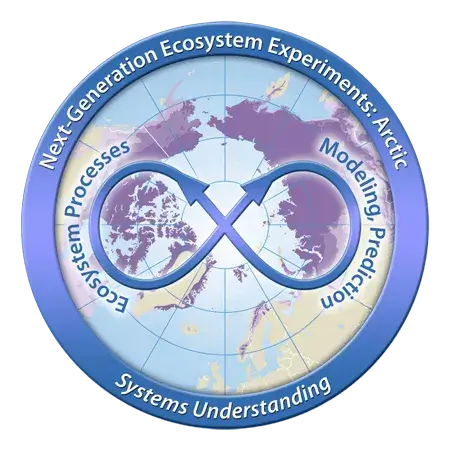2021
- Mekonnen, Zelalem A., et al. “Arctic Tundra Shrubification: A Review of Mechanisms and Impacts on Ecosystem Carbon Balance”. Environmental Research Letters, vol. 16, no. 5, 2021, p. 053001, https://doi.org/10.1088/1748-9326/abf28b.
- Wainwright, Haruko M., et al. “High-Resolution Spatio-Temporal Estimation of Net Ecosystem Exchange in Ice-Wedge Polygon Tundra Using In Situ Sensors and Remote Sensing Data”. Land, vol. 10, no. 7, 2021, p. 722, https://doi.org/10.3390/land10070722.
- Dengel, Sigrid, et al. “Influence of Tundra Polygon Type and Climate Variability on Carbon Dioxide and Methane Fluxes Near Utqiagvik, Alaska”. Journal of Geophysical Research: Biogeosciences, vol. 126, no. 12, 2021, https://doi.org/10.1029/2021JG006262.
- Watts, Jennifer D., et al. “Soil Respiration Strongly Offsets Carbon Uptake in Alaska and Northwest Canada”. Environmental Research Letters, vol. 16, no. 8, 2021, p. 084051, https://doi.org/10.1088/1748-9326/ac1222.
- Virkkala, Anna-Maria, et al. “Statistical Upscaling of Ecosystem Carbon Dioxide Fluxes across the Terrestrial Tundra and Boreal Domain: Regional Patterns and Uncertainties”. Global Change Biology, vol. 27, no. 17, 2021, pp. 4040-59, https://doi.org/10.1111/gcb.v27.1710.1111/gcb.15659.
2020
- Lehmann, Johannes, et al. “Persistence of Soil Organic Carbon Caused by Functional Complexity”. Nature Geoscience, vol. 13, no. 8, 2020, pp. 529-34, https://doi.org/10.1038/s41561-020-0612-3.
2019
- Arora, Bhavna, et al. “Evaluating Temporal Controls on Greenhouse Gas (GHG) Fluxes in an Arctic Tundra Environment: An Entropy-Based Approach”. Science of The Total Environment, vol. 649, 2019, pp. 284-99, https://doi.org/10.1016/j.scitotenv.2018.08.251.
- Wang, Yihui, et al. “Mechanistic Modeling of Microtopographic Impacts on Carbon Dioxide and Methane Fluxes in an Alaskan Tundra Ecosystem Using the CLM‐Microbe Model”. Journal of Advances in Modeling Earth Systems, vol. 11, 2019, p. 17, https://doi.org/10.1029/2019MS001771.
- Grant, Robert F., et al. “Modeling Climate Change Impacts on an Arctic Polygonal Tundra: 2. Changes in Carbon Dioxide and Methane Exchange Depend on Rates of Permafrost Thaw As Affected by Changes in Vegetation and Drainage”. Journal of GeophysicalResearch: Biogeosciences, vol. 124, no. 5, 2019, pp. 1323-41, https://doi.org/10.1029/2018JG004645.
2018
- Taş, Neslihan, et al. “Landscape Topography Structures the Soil Microbiome in Arctic Polygonal Tundra”. Nature Communications, vol. 9, no. 1, 2018, https://doi.org/10.1038/s41467-018-03089-z.
2017
- Raz-Yaseef, Naama, et al. “Evapotranspiration across Plant Types and Geomorphological Units in Polygonal Arctic Tundra”. Journal of Hydrology, vol. 553, 2017, pp. 816-25, https://doi.org/10.1016/j.jhydrol.2017.08.036.
- Raz-Yaseef, Naama, et al. “Large Carbon Dioxide and Methane Emissions from Polygonal Tundra During Spring Thaw in Northern Alaska”. Geophysical Research Letters, vol. 44, no. 1, 2017, pp. 504-13, https://doi.org/10.1002/2016GL071220.
- Grant, Robert F., et al. “Mathematical Modeling of Arctic Polygonal Tundra With Ecosys: 1. Microtopography Determines How Active Layer Depths Respond to Changes in Temperature and Precipitation”. Journal of Geophysical Research: Biogeosciences, vol. 122, no. 12, 2017, pp. 3161-73, https://doi.org/10.1002/2017JG004035.
- Grant, Robert F., et al. “Mathematical Modeling of Arctic Polygonal Tundra With Ecosys: 2. Microtopography Determines How Carbon Dioxide and Methane Exchange Responds to Changes in Temperature and Precipitation”. Journal of Geophysical Research: Biogeosciences, vol. 122, no. 12, 2017, pp. 3174-87, https://doi.org/10.1002/2017JG004037.
- Dwivedi, Dipankar, et al. “Mineral Properties, Microbes, Transport, and Plant-Input Profiles Control Vertical Distribution and Age of Soil Carbon Stocks”. Soil Biology and Biochemistry, vol. 107, 2017, pp. 244-59, https://doi.org/10.1016/j.soilbio.2016.12.019.
2016
- Xu, Xiyan, et al. “A Multi-Scale Comparison of Modeled and Observed Seasonal Methane Emissions in Northern Wetlands”. Biogeosciences, vol. 13, no. 17, 2016, pp. 5043-56, https://doi.org/10.5194/bg-13-5043-201610.5194/bg-13-5043-2016-supplement.
- Vaughn, Lydia J. S., et al. “Isotopic Insights into Methane Production, Oxidation, and Emissions in Arctic Polygon Tundra”. Global Change Biology, vol. 22, no. 10, 2016, pp. 3487-02, https://doi.org/10.1111/gcb.2016.22.issue-1010.1111/gcb.13281.
2015
- Wainwright, Haruko M., et al. “Identifying Multiscale Zonation and Assessing the Relative Importance of Polygon Geomorphology on Carbon Fluxes in an Arctic Tundra Ecosystem”. Journal of Geophysical Research: Biogeosciences, vol. 120, no. 4, 2015, pp. 788-0, https://doi.org/10.1002/2014JG002799.
- Throckmorton, Heather M., et al. “Pathways and Transformations of Dissolved Methane and Dissolved Inorganic Carbon in Arctic Tundra Watersheds: Evidence from Analysis of Stable Isotopes”. Global Biogeochemical Cycles, vol. 29, no. 11, 2015, pp. 1893-10, https://doi.org/10.1002/2014GB005044.
2014
- Riley, William J., et al. “Long Residence Times of Rapidly Decomposable Soil Organic Matter: Application of a Multi-Phase, Multi-Component, and Vertically Resolved Model (BAMS1) to Soil Carbon Dynamics”. Geoscientific Model Development, vol. 7, no. 4, 2014, pp. 1335-5, https://doi.org/10.5194/gmd-7-1335-2014.

